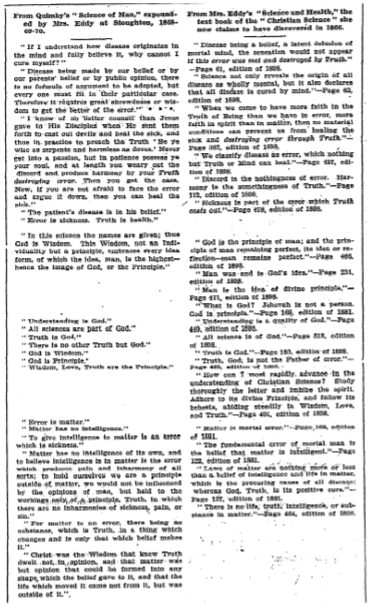This is one of several posts exploring the accusations of plagiarism leveled against Ms. Eddy, as well as what may have influenced the writing of Science & Health. This, and future posts dealing with this topic will be tagged MBEPlagerism.
This post contains affiliate links, thank you for supporting Kindism.org
The Mary Baker Eddy Library for the Betterment of Humanity has an extensive piece on Ms. Eddy’s relationship with P.P. Quimby. I highly recommend reading it: http://christianscience.com/var/mediafile/departments/clerk/bol/pdf/commonquimbyquestionshandout.pdf
Update – these PDFs appear to have been removed from the website!
I’ve mentioned Ms. Eddy’s relationship with P.P. Quimby (1) before, but have not yet done an in-depth piece on their relationship and P.P. Quimby as a source of “inspiration.”
While Ms. Eddy was undoubtedly influenced by Quimby, the general consensus is that the conclusions she came to are entirely her own. I particularly like Dakin’s analysis of this relationship when he writes
“Others of his pupils lost themselves in Quimby’s philosophy, but Mrs. Glover lost Quimby in herself” (Dakin, 92).
Eddy biographer, Gillian Gill devotes a number of pages to the issue of Ms. Eddy and P.P. Quimby, (2) taking a far more sympathetic stance on the subject than Dakin or Fraser. Gill systematically dissects any claims made by Quimby’s other students, mainly Julius and Horatio Dresser, poking holes in their claims, pointing out that they showed little interest in Quimby’s work after his passing until Ms. Eddy’s Christian Science started to gain popularity (Gill, 146).
One of the more interesting comparisons of P.P. Quimby’s work with Ms. Eddy’s is in the July 10, 1904 New York Times, in a piece entitled True Origin of Christian Science (3). Gill dismisses the piece as “bad faith or bad scholarship” (Gill, 231-232). “Bad scholarship” aside, it makes for interesting reading.
Gill’s assertions of poor scholarship are not entirely incorrect, as her claims are extensively footnoted. The main point of contention being that The Quimby Manuscripts, were not published by Horatio Dresser until 1921, by which point P.P. Quimby had been dead for over 50 years, and Christian Science was well established and thriving. Furthermore, they had not been given directly to Dresser, but had instead passed through several others before arriving with him (Gill, 121). Gill’s further research shows Dresser omitted papers that were not favorable to Quimby (Gill, 138) — the fact that the early Church attempted to suppress some of Ms. Eddy’s early work seems lost on her (Fraser
, 142).
Putting aside the scholarship and origin story issues — unless we get a time machine it is unlikely those will ever be sorted out, let us look at what comprised the core of Quimby’s teachings. There are several websites (see Further Reading below) that talk about Quimby’s work, one of them thoughtfully shared the following condensed list of Quimby’s ideas.
Seven Element List compiled by Horatio W. Dresser to explain Quimby’s ideas (4)
- The omnipresent Wisdom, the warm, loving Father of us all, Creator of all the universe, whose works are good, whose substance is an invisible reality.
- The real man, whose life is eternal in the invisible kingdom of God, whose senses are spiritual and function independently of matter.
- The visible world, which Dr. Quimby once characterized as “the shadow of Wisdom’s amusements”; that is, nature is only the outward projection or manifestation of an inward activity far more real and enduring.
- Spiritual matter, or fine interpenetrating substance, directly responsive to thought and subconsciously embodying in the flesh the fears, beliefs, hopes, errors, and joys of the mind.
- Disease is due to false reasoning in regard to sensations, which man unwittingly develops by impressing wrong thoughts and mental pictures upon the subconscious spiritual matter.
- As disease is due to false reasoning, so health is due to knowledge of the truth. To remove disease permanently, it is necessary to know the cause, the error which led to it. “The explanation is the cure.”
- To know the truth about life is therefore the sovereign remedy for all ills. This truth Jesus came to declare. Jesus knew how he cured and Dr. Quimby, without taking any credit to himself as a discoverer, believed that he understood and practiced the same great truth or science.
While there are undeniable parallels between the seven elements and Ms. Eddy’s teachings, neither the students of Quimby or Ms. Eddy wish them to be associated with one another. The Mary Baker Eddy Library for the Betterment of Humanity’s piece Ms. Eddy’s relationship with P.P. Quimby has a wonderful quote from Gottschalk’s Rolling Away the Stone (5). On page 72 he writes
George Quimby, a strong champion of his father’s originality, wrote, “Don’t confuse his method of healing with Mrs. Eddy’s Christian Science, so far as her religious teachings go… The religion which she teaches certainly is hers, for which I cannot be too thankful; for I should loath to go down into my grave feeling that my father was in any way connected with “Christian Science.”
Ms. Eddy biographer Gillian Gill, while not a Christian Scientist, takes several opportunities to poke holes in the Quimby/Eddy inspiration story (5). Short of discovering time travel and witnessing these events for ourselves, it seems unlikely this mess will ever be unraveled, and P.P. Quimby and Ms. Eddy forever be remembered together.
- https://kindism.org/tag/quimby/
- Mary Baker Eddy, by Gillian Gill
http://books.google.com/books?id=eiEMHjyvTGEC&printsec=frontcover&dq=Mary+Baker+Eddy,+Gill&hl=en&sa=X&ei=FS3GUfKOMcmZiQKY34GgDQ&ved=0CC8Q6AEwAA#v=onepage&q=Quimby&f=false
- New York Times, July 10, 1904 True Origin of Christian Science http://query.nytimes.com/mem/archive-free/pdf?res=9E01EFDC1138E430A75753C1A9619C946597D6CF
- http://phineasquimby.wwwhubs.com/
- http://christianscience.com/var/mediafile/departments/clerk/bol/pdf/commonquimbyquestionshandout.pdf
Further Reading
- Phineas Parkhurst Quimby: His Complete Writings and Beyond
- PHINEAS PARKHURST QUIMBY 1802 – 1866 Father of New Thought
- The Quimby Manuscripts
- Phineas Parkhurst Quimby Resource Center
- Thinking is Causative
- The Truth about Mary Baker Eddy
- http://www.sacred-texts.com/nth/qm/qm24.htm
- http://books.google.com/books?id=Yra4KhlMBYQC&pg=PA136&lpg=PA136&dq=How+Reverend+Wiggin+Rewrote+Mrs.+Eddy%27s+Book&source=bl&ots=_3eUjN1bmo&sig=oLVge5Ne31mLv8SoGgn0h0CPmRQ&hl=en&sa=X&ei=LiPGUdrpPOjXiALgq4DIBw&ved=0CF4Q6AEwCA#v=onepage&q=How%20Reverend%20Wiggin%20Rewrote%20Mrs.%20Eddy%27s%20Book&f=false
- http://www.archive.org/stream/lifeofmarybakerg00milmuoft/lifeofmarybakerg00milmuoft_djvu.txt

